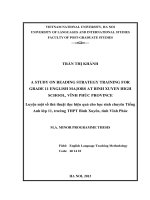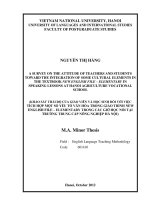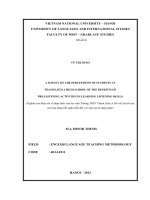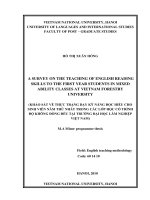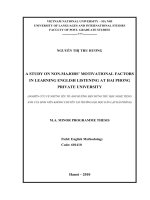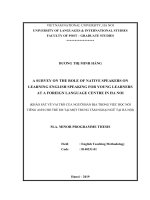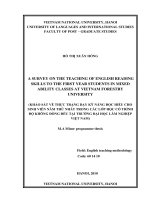A survey on the use of smartphone in learning english speaking skills of english majors at the vietnam national university of agriculture
Bạn đang xem bản rút gọn của tài liệu. Xem và tải ngay bản đầy đủ của tài liệu tại đây (962.11 KB, 42 trang )
VIET NAM NATIONAL UNIVERSITY OF AGRICULTURE
FACULTY OF EDUCATION AND FOREIGN LANGUAGES
BA THESIS
A SURVEY ON THE USE OF SMARTPHONE IN
LEARNING ENGLISH SPEAKING SKILLS OF ENGLISH
MAJORS AT THE VIETNAM NATIONAL UNIVERSITY
OF AGRICULTURE
KHẢO SÁT VIỆC SỬ DỤNG ĐIỆN THOẠI THÔNG MINH
TRONG VIỆC HỌC KỸ NĂNG NĨI TIẾNG ANH CỦA
SINH VIÊN CHUN NGÀNH NGƠN NGỮ ANH TẠI HỌC
VIỆN NÔNG NGHIỆP VIỆT NAM
Student: VU THI MO
Major: ENGLISH
Supervisor: TRAN THANH PHUONG, MA
Hanoi – 2021
CERTIFICATE OF ORIGINALITY
I certify that the work in this thesis has not previously been submitted for a
degree nor has it been submitted as part of requirements for a degree except as fully
acknowledged within the text.
I also certify that the thesis has been written by me. Any help that I have
received in my research work and the preparation of the thesis itself has been
acknowledged. In
addition, I certify that all information sources and literature used are indicated in the
thesis.
Hanoi, 2021
Vu Thi Mo
Approved by
SUPERVISOR
(Signature and full name)
Date:……………………
i
ACKNOWLEDGEMENT
Throughout the process of writing this research paper, I have received a great
deal of assistance, guidance, and encouragement from many teachers, friends, and
family members.
First of all, I would like to express my heartfelt gratitude to Ms. Tran Thanh
Phuong, one of my supervisors, for her consistent and unwavering support throughout
this study.
Next, I want to thank Ms. Nguyen Thu Thuy for her helpful advice and ideas.
My heartfelt gratitude also goes to the other teachers in the Foreign Language
Department for their lectures and instructions over the past four years, which have
greatly aided me in completing this study.
Thank you to the 120 English majors from K63 who assisted me in completing
the questionnaires and interviews.
Finally, I'd like to thank everyone who gave me advice and helped me find
sources while I was writing this thesis.
Thank you very much.
Sincerely.
ii
TABLE OF CONTENT
CERTIFICATE OF ORIGINALITY ......................................................................... i
ACKNOWLEDGEMENT .......................................................................................... ii
TABLE OF CONTENT ............................................................................................. iii
TABLE OF CHARTS ................................................................................................. v
ABSTRACT ................................................................................................................ vi
PART 1: INTRODUCTION ....................................................................................... 1
1.1. Rationale for the study ........................................................................................ 1
1.2. Aims and objectives of the study. ....................................................................... 2
1.2.1. Aims of the study. ..................................................................................................................2
1.2.2. Objectives of the study. .......................................................................................................2
1.3. Research questions. ............................................................................................. 2
1.4. Scope of the study. .............................................................................................. 3
1.5. Significance of the study. .................................................................................... 3
1.6. Design of the study. ............................................................................................. 3
PART II: DEVELOPMENT ...................................................................................... 5
CHAPTER 1: LITURATURE REVIEW .................................................................. 5
1.1. Review of the previous studies (at home & abroad) ........................................... 5
1.1.1 Related to the previous studies. (At home) ...................................................................5
1.1.2. Related to the previous studies. (Abroad) ....................................................................5
1.2. Review of theoretical background (depends on what the study is about). ......... 6
1.2.1 What is speaking skills? .......................................................................................................6
1.2.2. The importance of speaking skills...................................................................................7
1.2.3. Types of speaking skills. .....................................................................................................8
1.2.4. Characteristics of speaking. ............................................................................................ 10
1.2.5. Smartphones in learning English speaking skills. ................................................. 11
iii
CHAPTER II: METHODOLOGY .......................................................................... 13
2.1. Research methodology. ..................................................................................... 13
2.2. Research setting/context.................................................................................... 13
2.3. Data collecting procedures. ............................................................................... 13
2.4. The data analysis. .............................................................................................. 14
CHAPTER III. FINDING AND DISCUSSION ..................................................... 15
3.1. Smartphones and activities aimed to learn english speaking skills. ................. 15
3.2. Summary. .......................................................................................................... 22
3.3. Suggest some effective methods of learning english speaking skills through
smartphone. .............................................................................................................. 23
3.3.1. Learn English speaking skills through Youtube. ................................................... 23
3.3.2. Learn English speaking skills through websites. ................................................... 25
3.3.3. Learning English speaking skills through applications ....................................... 26
3.3.4. Leaning English speaking skills through social networks. ................................ 27
PART III: CONCLUSION. ...................................................................................... 28
1. Recapitulation....................................................................................................... 28
2. Limitation of the current research. ....................................................................... 29
3. Recommendations/implications/suggestions for further research............................. 29
REFERENCES .......................................................................................................... 31
SURVEY QUESTIONAIRE .................................................................................... 32
iv
TABLE OF CHARTS
Chart 1: Using smartphones in students' English speaking skills learning ......... 15
Chart 2: Students' time using smartphones to study English every day ............. 16
Chart 3: Methods of using smartphones to learn English speaking skills .......... 17
Chart 4: Apps/websites to learn english speaking skills on smartphones ........... 18
Chart 5: Effective methods when using smartphones for learning English speaking
skills? ................................................................................................... 19
Chart 6: Advantages of learning English on smartphone.................................... 20
Chart 7: The effect of using smartphones to learn English speaking skills ....... 21
v
ABSTRACT
It is a fact that speaking is a necessary skill in any language. However, in
practice, learning English speaking skills are still far from satisfactory. The research
focuses on the use of smartphones by English majors at the Vietnam National
University of Agriculture to improve their English speaking skills. The thesis is
divided into three sections: the introduction, the development, and the conclusion.
The introduction explains the rationale for the study and establishes the study's goals,
scope, and methods. The development - which is considered the most important part
of the study - consists of three chapters with distinct functions. The first chapter
covers all of the theoretical groundwork for speaking skills. The second chapter
investigates the current learning English speaking to the English majored students at
the Vietnam National University of Agriculture. This chapter also deals with the
research methodology which includes participants, the settings of the study, the data
collection methods, the data analysis. Chapter 3 is the findings and discussions.
Chapter 3 also provides some possible suggestions for improving English speaking
learning for English majors at the Vietnam National University of Agriculture. Part
three, the conclusion, summarizes the issues discussed and suggests some key points
for future research.
vi
PART 1: INTRODUCTION
1.1. RATIONALE FOR THE STUDY
Language enables us to interact with people. The importance of the English
language cannot be ignored, due to its role in social, political-economic, and
environmental development. English language functions as a vehicle of interaction
and an instrument of communication. According to Muhammad, Sani Ya’u, Aliya,
Hassan (2018) English is the lingua franca for most parts of the world. The need to
communicate effectively in the modern world is inarguable and in this context, the
demand for learning English as an international language among the non-native
speakers of English is growing daily (Richards, 2006 as quoted in Rahman, Singh, &
Pandian, 2018).
English is considered an international language, the need for mastery and use is
greater and greater. Understanding its importance, Vietnam - a country in the stage of
development, opening the door to the outside world, since then learning and using
English is more and more necessary than ever, especially speaking skills.
English is the most commonly used common language for communication.
Specially, speaking skills are important for career success, it can be said that
nowadays, when applying for a job, good English is an important factor in getting a
good job. In interviews, we must use our speaking skills fluently; the better our
speaking skills, the better the results. Speaking skills can enhance one’s personal life
and thereby bring about the well-rounded growth that we should all seek.
Smartphones are now not only used for the basic purpose of communication but
also as an effective learning tool as they have all the features of computers inbuilt in
them. This study explores students’ perspective about learning English via smartphone at
the university level as perception reflect people’s attitude and acceptability towards
something and affects their decisions too. Smartphones are very effective tools for
students to learn English speaking skills because they have many features that can
help us improve this skill. We will achieve high learning efficiency if we know how
1
to use smartphones to learn English speaking skills. Studies are already conducted to
investigate smartphone features for learning English speaking skills of English
majors at the Vietnam National University of Agriculture.
1.2. AIMS AND OBJECTIVES OF THE STUDY.
1.2.1. Aims of the study.
When writing this research paper, I set a primary goal of assisting students
understand the current state of students' learning English speaking skills through the use
of smartphones, thereby introducing students to some effective methods of learning
English speaking skills through smartphones.
1.2.2. Objectives of the study.
I have divided my study into 2 main objectives:
The first one was investigating the impact of smartphones in learning English
speaking skills of English majors at the Vietnam National University of Agriculture. I
conducted a survey to better understand the status of students' English speaking skills
and how they use their smartphones to learn this skill in order to determine the impact
of smartphones on their English speaking skills.
And the second one was suggesting English majors at the Vietnam National
University of Agriculture how to use smartphones to learn English effectively.
Following the completion of the survey data analysis I would like to offer tips on how
to effectively learn English speaking skills on smartphones.
1.3. RESEARCH QUESTIONS.
Two research questions were posed base on the study's purpose:
1. What were the impact of smartphones in learning English speaking skills of
English majors at the Vietnam National University of Agriculture.
2. What were suggestions for the effective use of smartphone to learn English
speaking skills of English majors at the Vietnam National University of Agriculture?
In turn, the research paper's content would provide answers to the research
questions.
2
1.4. SCOPE OF THE STUDY.
The study was about a survey on the use of smartphone in learning English
speaking skills of English majors at the Vietnam National University of Agriculture.
The study was focus on English speaking skills
The scope of the study included 120 English majors (Random 120 students of
K63 at the Vietnam National University of Agriculture, 25 students from K63ENGA,
25 students from K63ENGB, 25 students from K63ENGC, 20 students from
K63ENGD and 25 students from K63ENGE). The study began on 01/03/2021 and
finished on 30/06/2021.
1.5. SIGNIFICANCE OF THE STUDY.
Research was carried out to help English majors at the Vietnam National
University of Agriculture know how to use smartphones to improve speaking skills.
Perhaps students did not know how to use smartphones to improve their
English speaking skills previously. This research was carried out in order for all
students to be aware of this method and to be able to apply it to the learning process.
1.6. DESIGN OF THE STUDY.
Except for the acknowledgement, abstract, references, and appendices, this
research was conducted in three main parts: the introduction, the development and
the discussion.
Part 1: INTRODUCTION: It explains why this thesis' topic was chosen, as well as
the study's aims, scope, methods, research questions, and design.
Part 2: DEVELOPMENT: which consists of three chapters:
Chapter 1: Literature Review - presents the theoretical background related to the
definition of listening, the importance of listening skills and types of listening.
Chapter 2: Methodology – gives the research methods, research setting/ context, data
collection, and data analysis.
Chapter 3: Findings and Discussion - presents the survey's complete results as well as
a detailed analysis of the data collected.
3
Part 3: CONCLUSION - which presents the review of the study, suggestions for
further research and limitations of the study.
4
PART II: DEVELOPMENT
CHAPTER 1: LITURATURE REVIEW
1.1. REVIEW OF THE PREVIOUS STUDIES (AT HOME & ABROAD)
1.1.1 Related to the previous studies. (At home)
A study on how to improve English skills for the first year English majors in
Hai Phong private university by Luong Thi Huyen in 2019. The study has proposed
some effective methods to learn English speaking skills like teaching methods to
improve speaking skills, the language game, work group and pair group, telephone
conversations, and applicability of internet in studying, watching TV and video,
speaking English to yourself, taking part in the English club, watching your favorite
English videos, watching English movies and TV shows, checking grammar with
online English tests, reading e-books, articles, magazines every day and so on.
In “How to improve students’ English speaking skills” by Ho Minh Thu
(2011). There are no specific methods to improve English speaking skills for
students.
In conclusion issues that would be dealt with in my thesis: provide effective
methods of learning English speaking skills, especially the method of using
smartphones.
1.1.2. Related to the previous studies. (Abroad)
According to Effortless English teaching English since 1996, ways to improve
English speaking skills are as follows: find an English-speaking conversation partner,
make sure to listen as well as speak, record your conversation practice, surround yourself
with the English language, practice with music and movies, read aloud, talk to
yourself… There are many suggested ways to help students improve their speaking
skills.
And in another study “the impact of smartphones on student’s learning in
Ghanaian universities, a case study on college of technology education, Kumasi” by
E.F Morgan and Bismark Mante (2020). Research has shown features of smartphones
5
and the impact of smartphones among university students. In addition, the study has
given suggestions for using smartphones for learning.
And so, the preceding studies demonstrated methods for using smartphones to
learn English in general, but did not provide methods for learning specific skills,
particularly speaking skills. As a result, in my research, I will provide methods for
learning to speak fluently by using smartphones.
1.2. REVIEW OF THEORETICAL BACKGROUND (DEPENDS ON WHAT THE
STUDY IS ABOUT).
1.2.1 What is speaking skills?
According to the Oxford Pocket dictionary of Current English 2009 “Speaking
is the action of conveying information or expressing one thoughts and feelings in
spoken language. And speaking used to indicate the degree of accuracy intended in a
statement or the point of view from which it is made.”
In the book “Developing speaking skills” of David Scheter, published in 1999,
there is a definition that: “Speaking is to outer words or articulate sounds, as human
beings to express thoughts by words, as the organs may be so obstructed that a man
may not be able to speak”.
Meanwhile in the book “Collins Cobuild English for advanced learner 4th
edition’, published in 2007 definite that “Speaking is the activity of giving speech
and talks, to indicate the opinion you are giving”.
“Speaking is also understood is the productive skill in the oral mode. It, like
the oral skills, is more complicated than it seems at first and involves more than just
pronouncing words” (In the website Lingua Link Library, Version 3.5, published on
CD.ROM by SIL International 1998).
In a nutshell, speaking skills is the process by which a speaker conveys
information to one or more people. Oral communication is used to convey
information.
6
1.2.2. The importance of speaking skills.
In the present global world, communication plays a vital role in getting success
in all fields. Language is used as a tool for communication. Perfect communication is
not possible for people without using a language. Moreover, people cannot achieve
their aims, objectives, and goals without using proper language to communicate.
Therefore, there is a need for a language to communicate with others those who live
all around the globe. As English is considered the international language and is
spoken all over the world, it serves the purpose of communicating with the people
who live in different regions, states, countries, and continents of the world. Speaking
skills is the most important skill to acquire foreign or second language learning.
Among the four key language skills, speaking is deemed to be the most important
skill in learning a foreign or second language. Brown and Yuke (1983) say,
“Speaking is the skill that the students will be judged upon most in real-life
situations”.
According to Bueno, Madrid, and Mclaren (2006: 321), “Speaking is one of the
most difficult skills language learners have to face. Speaking is considered the most
important of the four language skills of English. Even the learners learn the language
for so many years they find it difficult to speak in real-time situations when it is
demanded.
In the modern world, it has become quite common to prove the candidates’
talents at the time of their job interviews and many of the selections are based on the
performance of the interview.
The job aspirants have to participate and prove
themselves in debates and group discussions where the performance or oral
communication skills of the candidates are primarily measured. Besides, the
professionals have to give oral presentations as they have to promote the products or
their companies or give training to the other colleagues. Furthermore, an effective
speaker can inspire the audience a lot and gain the complete attention of the audience
and maintain the same tempo until the end of his/her speech. So the audience
7
involves completely in the speaker’s speech and they sometimes forget the real world
and put their complete concentration on the speech. So, speaking skills play a vital
role as everything depends on the way how people communicate their messages with
others.
Speaking skills are the most essential skills for all the learners who wish to
learn English to enhance their career, improve business, build confidence levels, get
better job opportunities, make public speeches, attend interviews, participate in
debates and group discussions, give presentations and so on. In the present modern
world, everything is linked with speaking skills.
One who has good talent in
speaking can conquer the whole world. Having good communication is the passport
to get better employment opportunities. In modern interviews, the real talent of the
job aspirants is tested through their performance in group discussions, debates,
presentation skills and so on. Therefore, job seekers have to acquire good oral
communication skills in order to grab better opportunities.
Altogether, speaking skills are critical. If you have good speaking skills, you
will be able to convey your thoughts and desires to others in the most understandable
manner. It has excellent public speaking skills as well as a high level of
persuasiveness. A person with good communication skills will benefit greatly in life
and will have more opportunities to advance in their career.
1.2.3. Types of speaking skills.
According to the article “what are basic types of speaking” of
. The article shows us that there are the following types
of speaking skills:
Formal Speaking: Formal speaking is a type of speaking which does not
involve in any way personal matter. Formal speaking is a type of speaking in which
the speaker has to follow some norms and principles at the time whenever conveying
the message in the formerly and structured manner for the firm.
8
Informal Speaking: It takes place in an unstructured manner and outside of the
formal one. Informal speaking is a type of speaking which involves the personal
things that mean whenever people communicate informally, they never bound by
their organizational positions. Everybody free to tell anything to anybody. Informal
speaking just like speaking at home, among friends, neighbors, relatives, colleagues,
co- workers, etc.
Task-oriented speaking: This is the form of a formal speaking this type of
speaking is concerned with conversion among officers, employees, colleagues and
related to the organization is used for any problem within the firm or an organization
or to the organization.
Semi-Formal Speaking: This is the type of speaking which combines formal
and informal speaking. That means it is a type of speaking which is not fully formal
or fully informal.
Interpersonal Speaking: It is talking between two persons. This type of
speaking may be either formal or informal. It described informal speaking as what we
speak at home among friends, colleagues or relatives. It is a really most natural way
of speaking where is speaker has freedom from the artificial tone, accent and voice
modulation. Sometimes it depends on the nature and the mood of the person
according to that only the speaker started speaking in that way. This speaking takes
place mainly in offices between the person nearly in the same post.
Overall, there are five different types of speaking. They are Formal Speaking,
Informal Speaking, Task-oriented speaking, Semi-Formal Speaking, Interpersonal
Speaking. Depending on different contexts, we use different types of speaking skills.
Therefore, we should use different types of speaking skills for different purposes in
life.
9
1.2.4. Characteristics of speaking.
As for Martin Bygate (1997:12), in most speaking, the person to whom we are
speaking is in front of us and able to put us right if we make mistakes. He or she can also
generally show agreement and understanding, or incomprehension and disagreement.
Unlike readers or writers, speakers may need patience and imagination, too. While
talking, speakers need to take notice of the other and allow listeners chance to speak
it. It means that we take turns to speak. Brown, G (1983) and her colleagues point out
that a listener helps a speaker improve his performance as a speaker because being a
listener gives learners models to utilize when acting a speaker. In addition, being a
hearer first helps the learner appreciate the difficulties inherent in the task. It is clear
that giving a speaker experience in a hearer's role is more helpful than simple practice
in tasks in which a speaker is having real difficulties in appreciating what a particular
task required. Martin Bygate (1997:24,25) suggested that conversation can be
analyzed in term of routines, which are conventional ways of presenting information.
As far as we have known, there are two kinds of routine: " information routines" and
" interaction routines". Information routines frequently recur information structures,
including stories; descriptions of places and people; presentation of facts,
comparisons, instructions. Interaction routines are the ones based not so much on
sequences of kinds of terms occurring in typical kinds of interactions. These routines
thus can be characterized in broad terms including the kinds of terms typically
occurring in given situations, and the order in which the components are likely to
occur. By and large, the students can be much more confident in speaking English
with clear understanding and governing these skills. The oral skills, however, are
dependent on the knowledge of language they learn such as grammar, pronunciation
and vocabulary. In addition, students rely on common conventional expressions for
communicating specific meanings, particularly on the language environment. It is
unedited that classroom practice might not be similar to oral communication outside
classroom. In a foreign language classroom, practice is rather simple and far from
10
real life. For instance, contents of communication topics in class are decided by
teacher, whereas outside classroom speakers can express freely what they want. The
exact content is unpredictable. Regarding the reason for communicating in classroom,
learners speak to practice speaking, to get good marks, but in real life speakers have
their reasons for their speech.
To sum up, the characteristics of speaking skills are virtually limitless. It is not
limited to the topic of discussion. The more knowledgeable a person is, the more
valuable his or her words are and the more attention they receive. If a person has poor
speaking skills, the listener will feel uneasy and depressed; additionally, they will be
unable to convey all of their thoughts when speaking. Sometimes the speaker is at a
loss for words.
1.2.5. The use of smartphones in learning English speaking skills.
There are some types of learning through Smartphones: learning through
sound, learning through short text messages, learning through a chartical display,
learning through information obtained from data, learning through internet search and
learning through camera and video clips (Sevari, 2012).
Buchegger (2010) gives some suggestions for actively and creatively using
Smartphone in class. The suggestion encompasses various subjects and areas in
which utilize this technology imaginatively. The examples for using the Smartphone
as a means of creative learning in class as follow: mobile photo story, the mobile
video story, the mobile podcast, mobile application, mobile GPS, mobile inter faces,
the SMS language, SMS passage, everyday geometrical forms, Documenting a field
trip, the mobile record story, QR Codes, Digital flicker book and SMS poetry.
In general, the smartphone is a fantastic invention that can greatly assist us in
our daily lives; even more, we cannot deny its effectiveness in assisting us in
learning. Many students use smartphones to help them improve their English skills. It
11
is a good option for those who want to improve their English speaking skills,
especially with the use of smartphones.
12
CHAPTER II: METHODOLOGY
2.1. RESEARCH METHODOLOGY.
In this study, I used the quantitative research method: Data collection and data
analysis through questionnaires. For data collection purposes, a survey questionnaire
was created and distributed to the students. I analyzed the data to provide specific
numbers for the research.
2.2. RESEARCH SETTING/CONTEXT.
The research took place at the Vietnam National University of Agriculture. There
were 120 English majors of K63 (25 students from K63ENGA, 25 students from
K63ENGB, 25 students from K63ENGC, 20 students from K63ENGD and 25
students from K63ENGE) completed a survey to collect information about the use of
smartphones in learning English speaking skills of English majors at the Vietnam
National University of Agriculture from 1/3/2021-30/5/2021. Because of the COVID-19
situation, some surveys were conducted at the school, while the remainder were
conducted online. Following that, 12 of the 120 students would be invited to participate
in the interview, where they would be asked to answer more specifically about the
questions on the survey questionnaire.
2.3. DATA COLLECTING PROCEDURES.
I used the survey questionnaire in this research.
The survey was completed by the contribution of 120 English majors from K63
at the Vietnam National University of Agriculture.
The survey questionnaire included 7 questions (in English) and they were numbered
from 1 to 1. There were 5 to 10 options in the question. The informants might select
more than one option. Survey questions were questions that I created by myself for
my research. and I have the help of my supervisor Miss Tran Thanh Phuong to help
me edit and complete my survey question.
13
Base on the results of this survey, I was able to identify an appropriate method
for using smartphone to improve the English speaking skills of English majors at the
Vietnam National University of Agriculture.
2.4. THE DATA ANALYSIS.
The information gathered I process in Excel.
To analyzed survey data I used the Countif function in Excel to count numbers
in order to calculate the percentage. Charts will be used to display the calculated data.
Following the implementation of the survey, the statistics were totaled and displayed
in the seventeen charts below. Each chart was displayed the number of students who
chose the best answer for them in each question. This number was expressed in %
age units, and the chart types were column chart, bar chart, and pie chart. The data
was easily visible in the chart, and the explanations were located to the right or the
bottom of the chart.
14
CHAPTER III. FINDING AND DISCUSSION
3.1. SMARTPHONES AND ACTIVITIES AIMED TO LEARN ENGLISH
SPEAKING SKILLS.
Chart 1: Using smartphones in students' English speaking skills learning
Up to two-thirds of students used smartphones regularly to improve their
English speaking skills (specifically 25.9% students were very often and 46.3%
students were often). With the remaining one-third of students, 16.7% sometimes and
7.4% rarely used smartphones to improve their English speaking skills, and 3.7% had
never used the method studied.
In conclusion, it could be said that English speaking skills was a difficult skill
that must be practiced frequently. But how should you go about practicing? This
study would provide you with the answer to the question: "how to learn English
speaking skills on smartphones in the most effective way."
15
Chart 2: Students' time using smartphones to study English speaking skills every
day
According to the results of the survey, 13% of students spent 1.5-2 hours a day
learning speaking skills on smartphones and 1-1.5 hours too. They spent a significant
amount of time using their smartphones to thoroughly learn this. 25.9% (roughly onethird of students) used smartphones to practice speaking skills for 30 minutes to one
hour per day. In my opinion, this was the optimal time to learn this skill. The majority
of students (43.4 %) learned this skill in less than 30 minutes per day. Perhaps they
were uninterested in learning and had not discovered effective methods for learning
this skill on smartphones. Furthermore, only 3.7% of students used smartphones to
learn this skill about more than 2 hours. And 1% remaining did not use smartphone to
learn this skill.
All in all, most students spent a reasonable amount of time every day (about 30
minutes to 1 hour) learning English speaking skills on the smartphone; however,
many students spent more time studying it thoroughly. This was very commendable.
16
For those of you who were not really interested in learning English speaking skills
through this method, I hope that after reading my research, you will change your
mind.
Chart 3: Methods of using smartphones to learn English speaking skills
According to the chart, we were ranked first, with 64.8% of students choosing
to learn English speaking skills through videos. The next 55.6% of the students chose
social networking as a method of learning. Third, half of students (50%) prefer to use
apps or websites to improve their English speaking skills. Chatting with native
speakers via online programs came next (48.1%). Finally, 46.3% of students chose to
learn English speaking skills through practice exams or topics in the IELTS, TOEIC
test, and so on.
In short, as could be seen, these figures were roughly equal; the difference
between the most popular method of learning and the method with the fewest
students was only about 20%.
17
Chart 4: Apps/websites to learn english speaking skills on smartphones
According to the chart, the majority of students prefer YouTube to improve
their English speaking skills (57.4%) Because this was the world's largest video
sharing application, students could easily search for videos that would help them
improve their English speaking skills.
According to the chart, “Tflat, Cambridge, Oxford dictionaries” accounted for
48.1 % of the selection. These were mostly trusted and popular dictionaries because
students frequently encounter single-specialty words.
Had the same 42.6% choice rate as Doulingo a multilingual app where you
could study and had fun) and ELSA Practice Speaking English.
The method of learning through social networks was ranked fourth (with
39.8%). Here, students could follow English learning pages or study guide
livestreams. People could even connect with one another in order to learn together.
“BBC Learning English” was ranked fifth, with 29.6% of students choosing it.
This was an application from a major British media channel; it contains not only
daily news but also good articles appropriate for your level.
18
